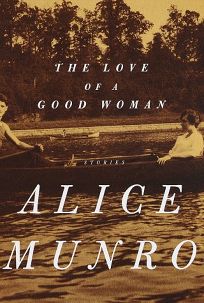The first and title story of Alice Munro's collection The Love of a Good Woman is one of her real masterpieces. At eighty pages, it's much longer than her stories usually are, but it's really a three-part story, the kind of work you can imagine beginning as an idea for a novel (as Munro says her stories often begin). In the first part, three boys come across a car at the bottom of a river, where the driver, a local optometrist, is drowned. Munro painstakingly explores why each of the boys, with their unique and specific home lives, wait so long to tell anyone about what they've seen. The second part is an account of a home nurse, Enid, who is taking care of a young and dying woman who intends on spreading her disgust and rage around as widely as possible at the end of her short life. Close to her death, this hateful woman confesses to Enid that she knows the secret about what really happened to the optometrist, Dr. Willens, a confession that sparks the third part, in which Enid, saddled with this new knowledge, must decide what she should do with it. Confront the newly revealed murderer? Or let dogs, sleeping now for decades, lie?
The story of the three boys may seem, at the end of the story, like a strange distraction from the story that resolves. We never see them again; they drop out of the narrative. But Enid slowly comes to consider that her patient's confession might have been a lie, a last-minute burst of pure diabolical venom meant to spread chaos after death. Munro, despite how some might perceive her, is no stranger to the deepest human darknesses; I think few other authors would have the courage to imagine a character whose deathbed provides so little in the way of reconciliation or resolution or redemption. But the experience of the boys who discover Dr. Willens' car is the only firsthand experience that is available. Because Enid can never be sure whether the story she receives is a lie or not, only the boys' story allows us to approach anything near to truth. Enid must resign herself to dealing only in possibility, though each possibility is only a different kind of evil.
The Love of a Good Woman is deeply interested in sickness, age, medicine, the body. There's the aging old Mr. Gorrie of "Cortes Island," who keeps his part-time babysitter at arm's length until he brings down an old scrapbook that implies he and his wife may have engineered a murderous arson years ago. (The parallels between this and "The Love of a Good Woman," neither of which is interested in providing the "real story," are rather obvious, I think.) In "My Mother's Dream," it's the death of an infant that unleashes the most horrible and hidden emotions in several women. (This story has the funny wrinkle of being written from the point-of-view of the infant, who in fact, did not die as was believed, and now is all grown up.) In "Before the Change," a story that feels sickeningly current, a woman realizes for the first time in her life that her father has been secretly providing abortions for decades. She opens up to him the story of her own child, long a secret, a child she's given away, but she doesn't notice that during her confession he has a debilitating stroke. Alice Munro is not interested in giving anyone closure.
And that's one of the most interesting things about her work, I think. Her stories often stretch across decades; they have prologues and codas that might as well have THIRTY YEARS EARLIER or THIRTY YEARS LATER written in bold across them. It's the kind of move you expect from authors who crave closure, who feel as if they must provide it, and yet, when Munro does it, it only complicates things. Trauma is not something that can be solved, though it can be transformed, accommodated, even ignored. In "The Children Stay," she gives a convincing portrait of a woman who chucks a comfortable life away to pursue an impulsive love affair, and who is tormented by the thought of leaving her kids, but not tormented enough not to do it:
This is acute pain. It will become chronic. Chronic means that it will be permanent but perhaps not constant. It may also meant hat you won't die of it. You won't get free of it, but you won't die of it. You won't feel it every minute, but you won't spend many days without it. And you'll learn some tricks to dull it or banish it, trying not to end up destroying everything you incurred this pain to get.
I don't think it's a coincidence, in this collection, that Munro returns to the language of disease--"chronic" and "acute" pain. She continually blurs the lines between physical and emotional pain. She brings this habit to an extreme in "Save the Reaper," in which a young girl, grieving the impending dissolution of a love triangle her mother has got caught up in, for reasons neither she nor Munro can fully articulate, dons her mother's wedding dress and then accidentally drags the train through a lit candle. The physical effects are permanent, though not life-ending. The symbolism is forever.


No comments:
Post a Comment